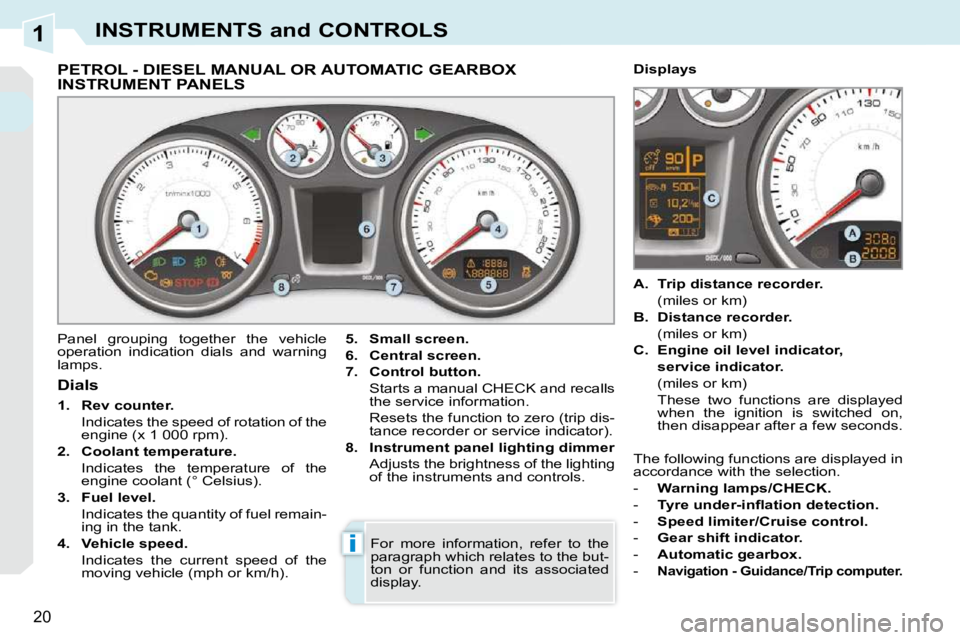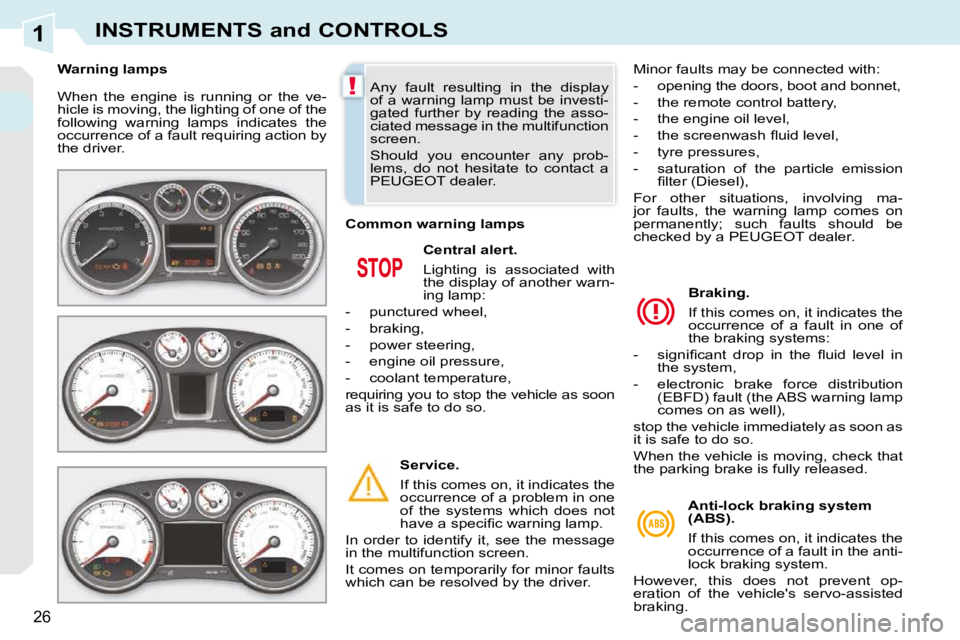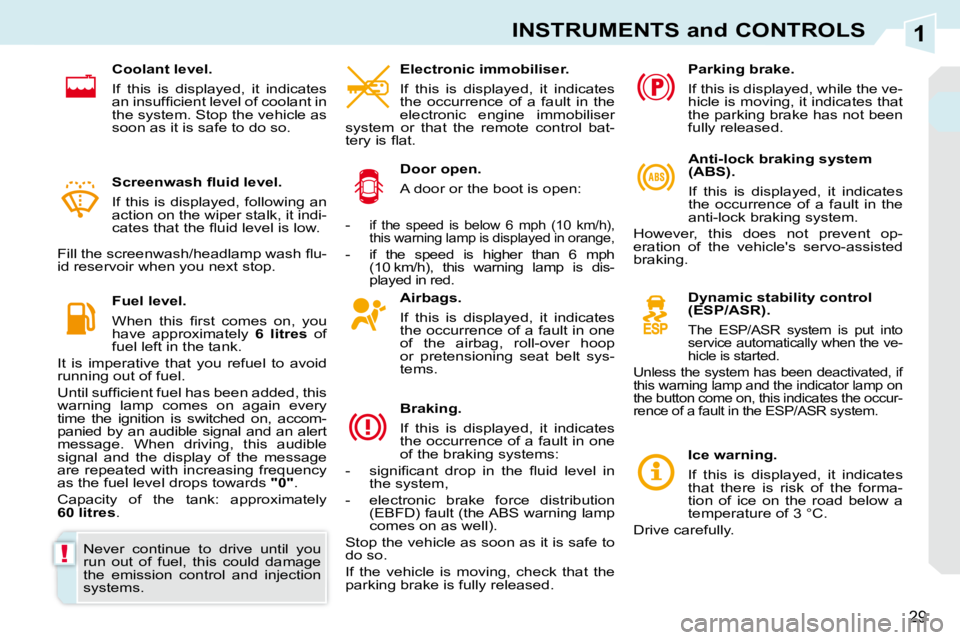2010 PEUGEOT 308 CC DAG check engine
[x] Cancel search: check enginePage 3 of 280

!
!
!
FAMILIARISATION
OPENING
Retractable roof The operation of the roof is the ex-
clusive responsibility of the driver.
To avoid any risk of injury when
operating the roof, ensure that no
one is standing near the moving
parts.
You are strongly advised not to op-
erate the roof in strong winds. When washing your vehicle:
- lock the vehicle using the re-
mote control or the key,
- avoid spraying the upper part of the windows,
- keep the end of the high pres- sure nozzle at least 1 metre
from the windows and door
seals.
When the vehicle has been
washed or after rain, wait until the
roof has dried before opening it. It is preferable to operate the roof
with the engine running and the
vehicle stationary. Wait until the
end of operation message ap-
pears in the multifunction screen
before moving off.
The operation can only be car-
ried out when moving if the speed
�i�s� �b�e�l�o�w� �6� �m�p�h� �(�1�0� � �k�m�/�h�)�,� �a�n�d�
you are driving smoothly on level
ground.
After the roof has been operated
fully four times in succession, the
system switches to protection
mode temporarily to avoid dam-
age to the roof motors. Let the
system rest for approximately ten
minutes; if you are unable to oper-
ate the roof after this time, contact
a PEUGEOT dealer.
Preliminary conditions
� Start the engine
� You must ensure that:
- the electric windows are initialised �(�s�e�e� �c�o�r�r�e�s�p�o�n�d�i�n�g� �s�e�c�t�i�o�n�)�,�
- the ambient temperature is higher than -15 °C.
Precautions to be taken before
operating the roof
� Park the vehicle on level ground.
� Check that no objects could hinder
the operation of the roof:
- nothing should be placed on the moving rear shelf 1 , on the boot
screen 2 or on the side trims 3 ,
- if luggage is transported in the boot, it must not lift the boot
screen,
- any objects, such as a jacket or umbrella, placed in the boot, must
be secured using the luggage re-
taining net 4 .
� Check that the boot screen 2 is se-
�c�u�r�e�d� �fi� �r�m�l�y�.�
� Close the boot correctly.
Page 17 of 280

1
i
20
INSTRUMENTS and CONTROLS
PETROL - DIESEL MANUAL OR AUTOMATIC GEARBOX INSTRUMENT PANELS
Panel grouping together the vehicle
operation indication dials and warning
lamps.
5. Small screen.
6. Central screen.
7. Control button.
Starts a manual CHECK and recalls the service information.
Resets the function to zero (trip dis- tance recorder or service indicator).
8. Instrument panel lighting
dimmer
Adjusts the brightness of the lighting of the instruments and controls.
Dials
1. Rev counter.
Indicates the speed of rotation of the engine (x 1 000 rpm).
2. Coolant temperature.
Indicates the temperature of the engine coolant (° Celsius).
3. Fuel level.
Indicates the quantity of fuel remain- ing in the tank.
4. Vehicle speed.
Indicates the current speed of the moving vehicle (mph or km/h).
A. Trip distance recorder.
(miles or km)
B. Distance recorder.
(miles or km)
C. Engine oil level indicator,
service indicator.
(miles or km)
These two functions are displayed when the ignition is switched on,
then disappear after a few seconds.
Displays
For more information, refer to the
paragraph which relates to the but-
ton or function and its associated
display. The following functions are displayed in
accordance with the selection.
-
Warning lamps/CHECK.
- �T�y�r�e� �u�n�d�e�r�-�i�n�fl� �a�t�i�o�n� �d�e�t�e�c�t�i�o�n�.
- Speed limiter/Cruise control.
- Gear shift indicator.
- Automatic gearbox.
-
Navigation - Guidance/Trip computer.
Page 18 of 280

1
i
21
INSTRUMENTS and CONTROLS
PETROL - DIESEL MANUAL OR AUTOMATIC GEARBOX PEUGEOT CONNECT MEDIA INSTRUMENT PANELS
Panel grouping together the vehicle
operation indication dials and warning
lamps.
5. Small screen.
6. Central screen.
7. Control button.
Starts a manual CHECK and recalls the service information.
Resets the function to zero (trip dis- tance recorder or service indicator).
8. Instrument panel lighting
dimmer
.
Adjusts the brightness of the lighting of the instruments and controls.
Dials
1. Rev counter.
Indicates the speed of rotation of the engine (x 1 000 rpm).
2. Coolant temperature.
Indicates the temperature of the engine coolant (° Celsius).
3. Fuel level.
Indicates the quantity of fuel remain- ing in the tank.
4. Vehicle speed.
Indicates the current speed of the moving vehicle (mph or km/h).
A. Trip distance recorder.
(miles or km)
B. Distance recorder.
(miles or km)
C. Engine oil level indicator,
se rvice indicator.
(miles or km)
These two functions are displayed when the ignition is switched on,
then disappear after a few seconds.
Displays
For further information, refer to the
paragraph which relates to the but-
ton or function and its associated
display. The following functions are displayed in
accordance with the selection.
-
Warning lamps/CHECK.
- �T�y�r�e� �u�n�d�e�r�-�i�n�fl� �a�t�i�o�n� �d�e�t�e�c�t�i�o�n�.
- Speed limiter/Cruise control.
- Gear shift indicator.
- Automatic gearbox.
-
Navigation - Guidance/Trip computer.
- Vehicle parameters.
Page 23 of 280

1
!
26
INSTRUMENTS and CONTROLS
When the engine is running or the ve-
hicle is moving, the lighting of one of the
following warning lamps indicates the
occurrence of a fault requiring action by
the driver. Central alert.
Lighting is associated with
the display of another warn-
ing lamp:
- punctured wheel,
- braking,
- power steering,
- engine oil pressure,
- coolant temperature,
requiring you to stop the vehicle as soon
as it is safe to do so.
Service.
If this comes on, it indicates the
occurrence of a problem in one
of the systems which does not
�h�a�v�e� �a� �s�p�e�c�i�fi� �c� �w�a�r�n�i�n�g� �l�a�m�p�.�
In order to identify it, see the message
in the multifunction screen.
It comes on temporarily for minor faults
which can be resolved by the driver. Braking.
If this comes on, it indicates the
occurrence of a fault in one of
the braking systems:
� � � �-� � �s�i�g�n�i�fi� �c�a�n�t� �d�r�o�p� �i�n� �t�h�e� �fl� �u�i�d� �l�e�v�e�l� �i�n� the system,
- electronic brake force distribution (EBFD) fault (the ABS warning lamp
comes on as well),
stop the vehicle immediately as soon as
it is safe to do so.
When the vehicle is moving, check that
the parking brake is fully released.
Any fault resulting in the display
of a warning lamp must be investi-
gated further by reading the asso-
ciated message in the multifunction
screen.
Should you encounter any prob-
lems, do not hesitate to contact a
PEUGEOT dealer.
Warning lamps
Anti-lock braking system
(ABS).
If this comes on, it indicates the
occurrence of a fault in the anti-
lock braking system.
However, this does not prevent op-
eration of the vehicle's servo-assisted
braking.
Common warning lamps
Minor faults may be connected with:
- opening the doors, boot and bonnet,
- the remote control battery,
- the engine oil level,
� � �-� � �t�h�e� �s�c�r�e�e�n�w�a�s�h� �fl� �u�i�d� �l�e�v�e�l�,�
- tyre pressures,
- saturation of the particle emission
�fi� �l�t�e�r� �(�D�i�e�s�e�l�)�,� �
For other situations, involving ma-
jor faults, the warning lamp comes on
permanently; such faults should be
checked by a PEUGEOT dealer.
Page 26 of 280

1
!
29
INSTRUMENTS and CONTROLS
Airbags.
If this is displayed, it indicates
the occurrence of a fault in one
of the airbag, roll-over hoop
or pretensioning seat belt sys-
tems.
Braking.
If this is displayed, it indicates
the occurrence of a fault in one
of the braking systems:
� � � �-� � �s�i�g�n�i�fi� �c�a�n�t� �d�r�o�p� �i�n� �t�h�e� �fl� �u�i�d� �l�e�v�e�l� �i�n� the system,
- electronic brake force distribution (EBFD) fault (the ABS warning lamp
comes on as well).
Stop the vehicle as soon as it is safe to
do so.
If the vehicle is moving, check that the
parking brake is fully released. Anti-lock braking system
(ABS).
If this is displayed, it indicates
the occurrence of a fault in the
anti-lock braking system.
However, this does not prevent op-
eration of the vehicle's servo-assisted
braking.
Dynamic stability control
(ESP/ASR).
The ESP/ASR system is put into
service automatically when the ve-
hicle is started.
Unless the system has been deactivated, if
this warning lamp and the indicator lamp on
the button come on, this indicates the occur-
rence of a fault in the ESP/ASR system.
Door open.
A door or the boot is open:
Ice warning.
If this is displayed, it indicates
that there is risk of the forma-
tion of ice on the road below a
temperature of 3 °C.
Drive carefully. Parking brake.
If this is displayed, while the ve-
hicle is moving, it indicates that
the parking brake has not been
fully released.
Electronic immobiliser.
If this is displayed, it indicates
the occurrence of a fault in the
electronic engine immobiliser
system or that the remote control bat-
�t�e�r�y� �i�s� �fl� �a�t�.� �
Fuel level.
� �W�h�e�n� �t�h�i�s� �fi� �r�s�t� �c�o�m�e�s� �o�n�,� �y�o�u�
have approximately 6 litres of
fuel left in the tank.
It is imperative that you refuel to avoid
running out of fuel.
� �U�n�t�i�l� �s�u�f�fi� �c�i�e�n�t� �f�u�e�l� �h�a�s� �b�e�e�n� �a�d�d�e�d�,� �t�h�i�s�
warning lamp comes on again every
time the ignition is switched on, accom-
panied by an audible signal and an alert
message. When driving, this audible
signal and the display of the message
are repeated with increasing frequency
as the fuel level drops towards "0" .
Capacity of the tank: approximately
60 litres .
� � �S�c�r�e�e�n�w�a�s�h� �fl� �u�i�d� �l�e�v�e�l�.�
If this is displayed, following an
action on the wiper stalk, it indi-
�c�a�t�e�s� �t�h�a�t� �t�h�e� �fl� �u�i�d� �l�e�v�e�l� �i�s� �l�o�w�.�
� �F�i�l�l� �t�h�e� �s�c�r�e�e�n�w�a�s�h�/�h�e�a�d�l�a�m�p� �w�a�s�h� �fl� �u�-
id reservoir when you next stop. -
if the speed is below 6 mph (10 km/h),
this warning lamp is displayed in orange,
- if the speed is higher than 6 mph
(10 km/h), this warning lamp is dis-
played in red.
Coolant level.
If this is displayed, it indicates
�a�n� �i�n�s�u�f�fi� �c�i�e�n�t� �l�e�v�e�l� �o�f� �c�o�o�l�a�n�t� �i�n�
the system. Stop the vehicle as
soon as it is safe to do so.
Never continue to drive until you
run out of fuel, this could damage
the emission control and injection
systems.
Page 27 of 280

1
AUTO
PRND
30
INSTRUMENTS and CONTROLS
Water in Diesel * .
If this is displayed, it indicates
the presence of water in the
�D�i�e�s�e�l� �fi� �l�t�e�r�.�
There is a risk of damage to the injection
system on Diesel engines. Automatic headlamp
adjustment.
If this is displayed, it indicates the
occurrence of a fault in the auto-
matic headlamp adjustment.
� � �P�a�r�t�i�c�l�e� �e�m�i�s�s�i�o�n� �fi� �l�t�e�r� �(�D�i�e�s�e�l�)�.�
If this is displayed, linked with
the service warning lamp, it in-
dicates the start of saturation
�o�f� �t�h�e� �p�a�r�t�i�c�l�e� �e�m�i�s�s�i�o�n� �fi� �l�t�e�r� �o�r� �a� �l�o�w�
Diesel additive reservoir level.
� �A�s� �s�o�o�n� �a�s� �t�r�a�f�fi� �c� �c�o�n�d�i�t�i�o�n�s� �p�e�r�m�i�t�,� �r�e�-
�g�e�n�e�r�a�t�e� �t�h�e� �fi� �l�t�e�r� �b�y� �d�r�i�v�i�n�g� �a�t� �a� �s�p�e�e�d�
of at least 40 mph (60 km/h) until the
service warning lamp is switched off.
If the service warning lamp is still dis-
played, the additive level is low. Have it
topped up by a PEUGEOT dealer with-
out delay.
� � � �U�n�d�e�r�-�i�n�fl� �a�t�e�d� �t�y�r�e�.�
If this is displayed, it indicates
low pressure in one or more
wheels.
Check the tyre pressures as soon as
possible.
Punctured tyre.
If this is displayed, it indicates
that one or more wheels are
punctured. Stop the vehicle as
soon as it is safe to do so.
Change the damaged wheel and have it
repaired by a PEUGEOT dealer.
� � �T�y�r�e� �u�n�d�e�r�-�i�n�fl� �a�t�i�o�n�
detection.
If this is displayed, it indicates
the occurrence of a fault on one
�o�f� �t�h�e� �s�e�n�s�o�r�s� �o�r� �i�n� �t�h�e� �t�y�r�e� �u�n�d�e�r�-�i�n�fl� �a�-
tion detection system.
It may also indicate the absence of a
sensor when the spare wheel, which
�d�o�e�s� �n�o�t� �h�a�v�e� �a� �s�e�n�s�o�r�,� �i�s� �fi� �t�t�e�d� �i�n� �p�l�a�c�e�
of a punctured wheel.
Automatic lighting.
If this comes on, it indicates the
occurrence of a fault in the au-
tomatic lighting.
Use the other positions of the lighting
stalk to control the lighting manually.
Visual and/or audible
parking sensors.
If this comes on, in forward and/
or reverse gear, it indicates a fault
in the parking sensor system.
Automatic gearbox.
If this is displayed, it indicates
the occurrence of a fault in the
automatic gearbox. The gear-
box will then operate in down-grade
mode, locked on 3rd gear.
It may also be displayed if a door is
opened.
Invalid value.
If this is displayed, it indicates
the occurrence of a fault in the
programme of the automatic
gearbox.
Position P or N.
If this is displayed, it indicates
that the gear lever must be
placed in position
P or N in or-
der to start the engine.
* According to country.
Power steering.
If this is displayed, it indicates
the occurrence of a fault in the
power steering. Stop the vehicle
as soon as it is safe to do so.
Page 29 of 280

1
i
32
INSTRUMENTS and CONTROLS
The level read will only be correct if
the vehicle is on level ground and
the engine has been off for more
than 15 minutes.
Engine oil level indicator
System which informs the driver whether
the engine oil level is correct or not.
This information is indicated for a few
seconds when the ignition is switched
on, after the service information.
Oil level correct
Lack of oil Oil level indicator fault
Dipstick
� �T�h�i�s� �i�s� �i�n�d�i�c�a�t�e�d� �b�y� �t�h�e� �fl� �a�s�h�i�n�g� �o�f�
"OIL" , linked with the service warning
lamp, accompanied by an audible sig-
nal and a message on the multifunction
screen.
� �I�f� �t�h�e� �l�a�c�k� �o�f� �o�i�l� �i�s� �c�o�n�fi� �r�m�e�d� �b�y� �a� �c�h�e�c�k�
using the dipstick, it is essential that the
level is topped up to prevent damage to
the engine. �T�h�i�s� �i�s� �i�n�d�i�c�a�t�e�d� �b�y� �t�h�e� �fl� �a�s�h�i�n�g� �o�f� �
"OIL
--" .
Consult a PEUGEOT dealer.
Refer to the "Checks" section to locate
�t�h�e� �d�i�p�s�t�i�c�k� �a�n�d� �t�h�e� �o�i�l� �fi� �l�l�e�r� �c�a�p� �o�n� �y�o�u�r�
engine.
There are 2 marks on the
dipstick:
- A = max; never exceed
this level (risk of dam-
age to the engine),
- B = min; top up the level
�v�i�a� �t�h�e� �o�i�l� �fi� �l�l�e�r� �c�a�p�,� �u�s�-
ing the grade of oil suit-
ed to your engine.
Page 32 of 280

1
35
INSTRUMENTS and CONTROLS
Manual Check
This function allows you to check the sta-
tus of the vehicle (reminder of the alert
�w�a�r�n�i�n�g�s� �a�n�d� �o�f� �t�h�e� �s�t�a�t�e� �o�f� �t�h�e� �c�o�n�fi� �g�u�-
rable functions - "activated" or "deacti-
vated") and the service information.
� With the engine running, to start
�a� �m�a�n�u�a�l� �c�h�e�c�k�,� �b�r�i�e�fl� �y� �p�r�e�s�s� �t�h�e�
"CHECK/000" button on the instru-
ment panel. If no faults have been detected,
"CHECK OK" appears in the instru-
ment panel central screen.
If a "minor" fault has been detected, the
warning lamp concerned then "CHECK
OK" appear in the instrument panel
central screen. Consult a PEUGEOT
dealer.
If a "major" fault has been detected, only
the warning lamps concerned appear
in the instrument panel central screen.
Have it checked by a PEUGEOT dealer.
Distance recorders
The total and trip distances are displayed
for thirty seconds when the ignition is
switched off, when the driver's door is
opened and when the vehicle is locked
or unlocked. Total distance recorder
Measures the total distance travelled by
�t�h�e� �v�e�h�i�c�l�e� �s�i�n�c�e� �i�t�s� �fi� �r�s�t� �r�e�g�i�s�t�r�a�t�i�o�n�.� � �
� With the ignition on, press and hold
this button until zeros appear.
Trip distance recorder
Measures a distance travelled since it
was reset to zero by the driver.